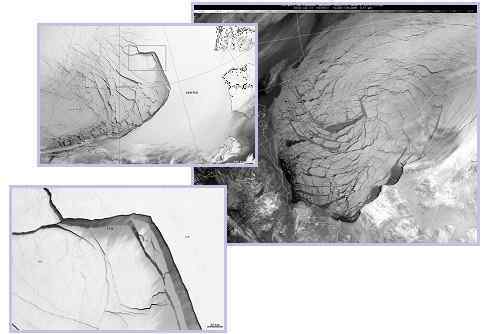Wild Weather, the Wobble Effect
|
Weather: |
Tides and Whirlpools:
|
"We warned at the start of ZetaTalk, in 1995, that unpredictable weather extremes, switching about from drought to deluge, would occur and increase on a lineal basis up until the pole shift. Where this occurred steadily, it has only recently become undeniable. ZetaTalk, and only ZetaTalk, warned of these weather changes, at that early date. Our early warnings spoke to the issue of global heating from the core outward, hardly Global Warming, a surface or atmospheric issue, but caused by consternation in the core. Affected by the approach of Planet X, which was by then starting to zoom rapidly toward the inner solar system for its periodic passage, the core was churning, melting the permafrost and glaciers and riling up volcanoes. When the passage did not occur as expected in 2003 because Planet X had stalled in the inner solar system, we explained the increasing weather irregularities in the context of the global wobble that had ensued - weather wobbles where the Earth is suddenly forced under air masses, churning them. This evolved by 2005 into a looping jet stream, loops breaking away and turning like a tornado to affect the air masses underneath. Meanwhile, on Planet Earth, droughts had become more intractable and deluges positively frightening, temperature swings bringing snow in summer in the tropics and searing heat in Artic regions, with the violence of storms increasing in number and ferocity."
From the ZetaTalk Chat Q&A for February 4, 2012:
The wobble seems to have changed, as the temperature in Europe suddenly plunged after being like an early Spring, Alaska has its coldest temps ever while the US and much of Canada is having an extremely mild winter. India went from fatal cold spell to balmy again. Has the Earth changed position vs a vs Planet X to cause this? [and from another] Bitter cold records broken in Alaska - all time coldest record nearly broken, but Murphy's Law intervenes [Jan 30] http://wattsupwiththat.com/2012/01/30/bitter-cold-records-broken-in-alaska Jim River, AK closed in on the all time record coldest temperature of -80°F set in 1971, which is not only the Alaska all-time record, but the record for the entire United States. Unfortunately, it seems the battery died in the weather station just at the critical moment. While the continental USA has a mild winter and has set a number of high temperature records in the last week and pundits ponder whether they will be blaming the dreaded "global warming" for those temperatures, Alaska and Canada have been suffering through some of the coldest temperatures on record during the last week.
There has been no change in the wobble pattern, the wobble has merely become more severe. Nancy noted a Figure 8 format when the Earth wobble first became noticeable, in early 2005, after Planet X moved into the inner solar system at the end of 2003. The Figure 8 shifted along to the east a bit on the globe between 2005 and 2009, (the last time Nancy took its measure) as Planet X came closer to the Earth, encountering the magnetic N Pole with a violent push earlier in the day. But the pattern of the Figure 8 remained essentially the same. So what changed recently that the weather patterns became noticeably different in late January, 2012?
The N Pole is pushed away when it comes over the horizon, when the noon Sun is centered over the Pacific. This regularly puts Alaska under colder air, with less sunlight, and thus the historically low temps there this January, 2012 as the wobble has gotten stronger. But by the time the Sun is positioned over India, the N Pole has swung during the Figure 8 so the globe tilts, and this tilt is visible in the weather maps from Asia. The tilt has forced the globe under the hot air closer to the Equator, warming the land along a discernable tilt demarcation line.
The next loop of the Figure 8 swings the globe so that the N Pole moves in the other direction, putting the globe again at a tilt but this time in the other direction. This tilt is discernable in weather maps of Europe, again along a diagonal line. Depending upon air pressure and temperature differences, the weather on either side of this diagonal line may be suddenly warm or suddenly cold. The tilt and diagonal line lingers to affect much of the US and Canada, but the Figure 8 changes at this point to be an up and down motion, pulling the geographic N Pole south so the US is experiencing a warmer than expected winter under a stronger Sun. Then the cycle repeats, with the magnetic N Pole of Earth pushed violently away again as the Sun is positioned over the Pacific.
From the ZetaTalk Chat Q&A for April 6, 2013:
Would the Zetas be able to let us know what is causing the early break-up of the Arctic Ice, the ice seems to have taken on a swirling pattern at the same time, would this be wobble related? [and from another] http://www.vancouversun.com/news/national/Canada+Arctic+cracks+spec... The ice in Canada’s western Arctic ripped open in a massive “fracturing event” this spring that spread like a wave across 1,000 kilometres of the Beaufort Sea. Huge leads of water – some more than 500 kilometres long and as much as 70 kilometres across – opened up from Alaska to Canada’s Arctic islands as the massive ice sheet cracked as it was pushed around by strong winds and currents. It took just seven days for the fractures to progress across the entire area from west to east. [and from another] http://earthobservatory.nasa.gov/IOTD/view.php?id=80752&src=iot... A high-pressure weather system was parked over the region, producing warmer temperatures and winds that flowed in a southwesterly direction. That fueled the Beaufort Gyre, a wind-driven ocean current that flows clockwise. The gyre was the key force pulling pieces of ice west past Point Barrow, the northern nub of Alaska that protrudes into the Beaufort Sea.
The Figure 8 formed by the N Pole during the daily Earth wobble has shifted somewhat to the East, due to Planet X positioned more to the right of the Earth during its approach. This was anticipated, and well described in ZetaTalk, the Earth crowding to the left in the cup to escape the approach of Planet X, so the angle between these two planets would change slightly. This shift of the Figure 8 to the East is due to the push against the Earth’s magnetic N Pole occurring sooner each day than prior. Thus instead of occurring when the Sun is high over the Pacific, over New Zealand, it is now occurring when the Sun is high over Alaska. All the wobble points have shifted eastward accordingly.
This has brought a lingering Winter to the western US, and a changed sloshing pattern to the Arctic waters. Instead of Pacific waters being pushed through the Bering Straits into the Arctic when the polar push occurs, the wobble is swinging the Arctic to the right, and then later to the left, creating a circular motion in the waters trapped in the Arctic. Since the Earth rotates counterclockwise, the motion also takes this path. This is yet another piece of evidence that the establishment is hard pressed to explain. They are attempting to ascribe this to high pressure and wind, all of which are not new to the Arctic, but this circular early breakup of ice in the Arctic is new.
Comment
-
Comment by KM on January 3, 2013 at 2:09pm
-
India: More Than 100 Die Of Exposure As Temperatures Drop In The North
AP | Posted: 01/03/2013 2:21 am EST | Updated: 01/03/2013 4:31 am EST
 A homeless child sits wrapped in a towel in his temporary home under a flyover in Jammu, India, on Jan. 2,2013. (AP Photo/Channi Anand)
A homeless child sits wrapped in a towel in his temporary home under a flyover in Jammu, India, on Jan. 2,2013. (AP Photo/Channi Anand)LUCKNOW, India (AP) — Police say more than 100 people have died of exposure as northern India deals with historically cold temperatures.
Police spokesman Surendra Srivastava said Thursday that at least 114 people have died from the cold in the state of Uttar Pradesh. At least 23 of those died in the past 24 hours.
Srivastava said many of the dead were poor people whose bodies were found on sidewalks or in parks.
The weather department said temperatures in the state were 4 to 10 degrees Celsius (7 to 18 degrees Fahrenheit) below normal.
Temperatures in New Delhi, which borders Uttar Pradesh, hit a high Wednesday of 9.8 degrees (49.6 Fahrenheit), the lowest maximum temperature in the capital since 1969.
-
Comment by Sevan Makaracı on January 3, 2013 at 12:58pm
-
Unseasonable snow falls in South Island (Jan 3)
A sodden South Island will have the chance to dry off over the next few days, after a front which brought gales, torrential rain, thunderstorms and unseasonal snow to the south moves off the country.
-
Comment by Sevan Makaracı on January 2, 2013 at 2:34pm
-
East coast, and Southern Australia Brace for Heat waves (Jan 1)
Severe Fire Dangers are forecast for most of South Africa, just a day after a bush fire started in the Clare valley. Authorities have warned today that any blaze that is sparked today is likely to be fast moving and uncontrollable. Some parts of Queensland are also facing dangerous fire conditions with Northwest Queensland expected to have temperature of 43 degrees. The state of Victoria is also preparing for a record breaking heat wave.
-
Comment by Howard on December 28, 2012 at 7:34am
-
Usually a harbinger of Spring, daffodils are blooming 2 months early in the U.K. (Dec 25)
http://www.dailymail.co.uk/news/article-2253108/The-Christmas-daffo...
The Christmas Daffodil?
Keen gardener said that the flowers are his earliest blooms yet.
While most of the UK continues to be deluged by rain - the early signs of spring have already made an appearance in one Devon town.
Keen gardener Brian Rickard saw the first daffodils in his Plymouth, Devon, flowerbeds bloom in time for Christmas.
The bright yellow flower made an appearance despite the town enduring 128.8mm of rain already in December - surpassing its monthly average for this time of year of 118.8mm.

In bloom: Keen gardener Brian Rickard is pictured outside his Plymouth, Devon, home with his daffodils which have flowered in time for Christmas


Spring on its way: Brian Rickard, right, says neither he, nor his wife Mary, knew what variety the bulbs were

Looking good: Although Mr Rickard usually sees his daffodils flower in December, he says that this is the earliest they have ever made an appearance
Although Mr Rickard usually sees his daffodils flower in December, he says that this is the earliest they have ever made an appearance.
Mr Rickard said: 'They have been out since December 15. Everybody who goes past is amazed.
'We always seem to have the first out. People are always saying "how on earth do you do it?".
'We don’t do anything at all. We just planted them and left them. I think it is because we are in a sheltered valley.
He added: 'These are in the front garden, which is south facing so it’s a bit warmer.'

Three girls spot early daffodils as they walk to the pub for Christmas lunch in Westward Ho!, North Devon
Brian, 73, a retired university technician, said neither he, nor his wife Mary, knew what variety the bulbs were.
'I haven’t a clue,' he said.
'It’s team work. Mary does the weeding and I do the planting and digging.
'It does cheer you up, seeing daffodils at Christmas.'
Although normally planted in Autumn, daffodils develop their roots over several months before flowering in the spring.
Mr Rickard's daffodils were not the only ones to flower two months early.
More daffodils were spotted in Westward Ho!, Devon.
-
Comment by Howard on December 26, 2012 at 8:41pm
-
Record Number of Christmas Tornadoes, Blizzards Tear Through U.S. (Dec 25)
The National Weather Service said there were a record 34 tornadoes reported in Texas, Louisiana, Mississippi and Alabama on Tuesday.
A state of emergency was declared in Mississippi, where homes, roads and businesses were damaged in at least nine counties. Eight people were injured but expected to survive, officials said.
A tornado watch was issued Wednesday for the eastern Carolinas until 5:00 p.m. ET.
At one point late Tuesday, holiday celebrations went dark for at least 150,000 customers in Alabama; electricity had been restored to all but 8,500 by the next morning, according to Alabama Power.
The worst of the tornadoes hit Tuesday afternoon in Mobile, Ala. Along with brutal, straight-line winds, the storms knocked down countless trees, blew the roofs off homes and left many Christmas celebrations in the dark. Torrential rains drenched the region and several places saw flash flooding.
Rick Cauley, who was hosting relatives for Christmas, got everyone in the house to a shelter at the high school down the block.
"As luck would have it, that's where the tornado hit," Cauley told The Associated Press. "The pressure dropped and the ears started popping and it got crazy for a second."
Mobile Press-Register reporter John Sharp wrote that he hunkered down in his bathtub in the fetal position while the power flickered off and the twister roared around his building.
When he walked outside, he was stunned. The roof of a small shopping center had caved in, and several cars in a restaurant parking lot were destroyed.
“Visibly, it was like a bomb has gone off at The Loop,” he wrote. “A one-way street sign was literally sawed into half. The Dauphin Island Parkway/Airport Boulevard sign was flattened. Power lines were lying on the ground.
Mobile’s Trinity Episcopal Church lost a large section of its roof and a wall, but officials were looking on the bright side. Hours before the tornado touched down, there were 500 people in the church for Christmas Eve services.
Blizzard Conditions Across 8 States
At least eight states were issued blizzard warnings, as the storms made highways dangerously slick heading into one of the busiest travel days of the year. The death toll rose to six with car accidents on snow and sleet-slickened highways in Arkansas and Oklahoma.
Indianapolis had 7 inches on the ground by 10 a.m. after receiving as much as 3 inches of snow in a single hour making it one of the strongest snowstorms in years to strike central and southern Indiana.
Ice accumulation in Arkansas bent trees and power lines, leaving at least 50,000 customers across the state without power. About 10 inches of snow fell on Fayetteville, Ark.
Fifty-two Indiana counties have travel restrictions in place during the blizzard.
Motorists were stranded Wednesday morning on State Road 37 southbound at the Monroe-Morgan county line.
Indiana State police say slick, snow-covered road conditions on an incline in the area stalled 40 to 50 cars. An Indiana Department of Transportation truck tried to clear the area, but ended up in a ditch.
All roads, including SR37, SR46 and SR45 in the Bloomington District remain snow covered, slick and extremely hazzardous. Some areas are down to one lane and some remain impassable.
More than 100 Indiana National Guard soldiers and airmen have been activated Wednesday to assist the citizens and communities of Indiana, Indiana State Police troopers and local authorities throughout the state under the direction of Indiana Department of Homeland Security.
National Guard personnel will deploy 10 Highway Assistance Teams, consisting of a total of 40 personnel, that will augment emergency personnel with the evacuation of stranded motorists and shut-ins.
Additionally, six Armory Support Packages, consisting of a total of 24 personnel, have been initiated to provide life support and vehicle staging operations to emergency personnel during IDHS operations.
More than 900 flights around the U.S. were canceled as of Wednesday midday, according to the flight tracker FlightAware.com. The cancelations were mostly spread around airports that had been or soon would be in the path of the storm.
Sources
http://usnews.nbcnews.com/_news/2012/12/26/16166853-power-crews-scr...
http://abcnews.go.com/US/nasty-winter-storms-spawn-tornadoes-blizza...
http://tribstar.com/latest/x1303500919/Indiana-National-Guard-respo...
-
Comment by Sevan Makaracı on December 25, 2012 at 1:28pm
-
WEATHER GOES INSANE OVER EUROPE: White Christmas for Moscow while south Europe sweats
From deadly cold in Russia, floods in Britain and balmy conditions that have residents in southwest France rummaging for their bathing suits, the weather has gone haywire across Europe in the days leading up to Christmas.
The mercury in Moscow has fallen to minus 25 degrees Celsius (minus 13 degrees Fahrenheit) -- unseasonably cold in a country where such chills don't normally arrive until January or February.
The cold has claimed 90 lives in Russia since mid-December and 83 in Ukraine, with eastern Eurasia in the grips of an unusually icy month that has seen temperatures drop to as low as minus 50 degrees C in eastern Siberia.
Another 57 people have died from the cold in Poland this month, and officials say the icy front is probably "the most severe of the last 70 years," according to Regis Crepet, a forecaster with Meteo-Consult.
While the former Eastern bloc shivers and Britain fights severe flooding after heavy rains, holiday-makers and residents in the south of France and in Italy have dug out their shorts and swimwear to welcome an unexpected blast of beach weather.
Temperatures on Sunday climbed to 24.3 degrees C in Biarritz on the Atlantic coast, nearly 12 degrees hotter than the seasonal average, and nudging the 1983 record of 24.4 degrees C.
"These are remarkable temperatures that we do not see every year," French weather forecaster Patrick Galois said.
In Catania on Italy's Sicily coast, beach temperatures on Christmas day are forecast to climb as high as 22 degrees C in some places, while in Austria, the small village of Brand at an altitude of more than 1,000 metres (3,200 feet), noted a December 24 record of 17.7 degrees C.
-
Comment by Mark on December 25, 2012 at 8:52am
-
round up of the year's crazy weather in the UK:
A heatwave in March, a twister in Bicester and the wettest summer on record: Britain’s topsy turvy weather which kept Britain talking
http://www.dailymail.co.uk/news/article-2252965/A-heatwave-March-tw...
-
Comment by Sevan Makaracı on December 24, 2012 at 3:08pm
-
ANTARCTICA: RAINFALL FOR THE FIRST TIME IN 9 YEARS, SYOWA STATION (DEC 23)
Rainfall was observed at Syowa station, Antarctica ) ( Japan time yesterday afternoon-23, dawn, 22. Japan Meteorological Agency recorded at Syowa station said rain is 1/1/2004 about nine years.
9:30 It began to sleet and rain too much said 11: 22, Syowa station and intermittently continued to fall until the night. 4.6 Degrees maximum temperature, minimum temperature 0.9 degrees and became a rare day not less than 0 degrees.
-
Comment by Sevan Makaracı on December 24, 2012 at 1:20pm
-
Rare Christmas Snow for Dallas, OKC, Little Rock (Dec 24)
-
Comment by Derrick Johnson on December 24, 2012 at 6:45am
-
Mississippi river faces shipping freeze as water levels drop
Navigation has become treacherous as the worst US drought in half a century brings water levels close to record lows
The Mississippi as seen from Ed Drager's tug boat is a river in retreat: a giant beached barge is stranded where the water dropped, with sand bars springing into view. The floating barge office where the tugboat captain reports for duty is tilted like a funhouse. One side now rests on the exposed shore. "I've never seen the river this low," Drager said. "It's weird."
The worst drought in half a century has brought water levels in the Mississippi close to historic lows and could shut down all shipping in a matter of weeks – unless Barack Obama takes extraordinary measures.
It's the second extreme event on the river in 18 months, after flooding in the spring of 2011 forced thousands to flee their homes. Without rain, water levels on the Mississippi are projected to reach historic lows this month, the national weather service said in its latest four-week forecast.
"All the ingredients for us getting to an all-time record low are certainly in place," said Mark Fuchs, a hydrologist at the National Oceanic and Atmospheric Administration (Noaa) in St Louis. "I would be very surprised if we didn't set a record this winter."
The drought has created a low-water choke point south of St Louis, near the town of Thebes, where pinnacles of rock extend upwards from the river bottom making passage treacherous.
Shipping companies are hauling 15 barges at a time instead of a typical string of 25, because the bigger runs are too big for the operating conditions.
Barges are carrying lighter loads, making for more traffic, with more delays and back-ups. Stretches of the river are now reduced to one-way traffic. A long cold spell could make navigation even trickier: shallow, slow-moving water is more likely to get clogged up with ice.
Current projections suggest water levels could drop too low to send barges through Thebes before the new year – unless there is heavy rainfall.
Local television in St Louis is dispensing doom-laden warnings about rusting metal and hazardous materials exposed by the receding waters.
Shipping companies say the economic consequences of a shutdown on the Mississippi would be devastating. About $7bn (£4.3bn) in vital commodities – typically grain, coal, heating oil, and cement – moves on the river at this time of year. Cutting off the transport route would have an impact across the mid-west and beyond.
The potential closure of the Mississippi river due to low water levels has raised concern for barge companies and others who use the river for shipping. Photograph: James West/Climate Desk
"There are so many issues at stake here," said George Foster, owner of JB Marine Services. "There is so much that moves on the river, not just coal and grain products, but you've got cement, steel for construction, chemicals for manufacturing plants, petroleum plants, heating oil. All those things move on the waterways, so if it shuts down you've got a huge stop of commerce."
Companies which ship their goods on the river are talking about lay-offs, if the Mississippi closes to navigation. Those would be just the first casualties, Foster said. "It is going to affect the people at the grocery store, at the gas pump, with home construction and so forth."
And it's going to fall especially hard on farmers, who took a heavy hit from the drought and who rely on the Mississippi to ship their grain to export markets. Farmers in the area lost up to three-quarters of their corn and soya bean crops to this year's drought. Old-timers say it was the worst year they can remember.
"We have been through some dry times. In 1954 when my dad and grandfather farmed here they pretty much had nothing because it was so dry," said Paul McCormick who farms with his son, Jack, in Ellis Grove, Illinois, south of St Louis. "But I think this was a topper for me this year."
Now, however, farmers are facing the prospect of not being able to sell their grain at all because they can't get it to market. The farmers may also struggle to find other bulk items, such as fertiliser, that are typically shipped by barge.
"Most of the grain produced on our farm ends up bound for export," said Jack McCormick, who raises beef cattle and grain with his father. "It ends up going down the river. That is a very good market for us, and if you can't move it that means a lower price, or you have to figure out a different way to move it. It all ends up as a lower price for the farmers."
The shipping industry in St Louis wants the White House to order the release of more water from the Missouri river, which flows into the Mississippi, to keep waters high enough for the long barges to float down the river to New Orleans.
Foster said the extra water would be for 60 days or so – time for the US army corps of engineers to blast and clear the series of rock pinnacles down river, near the town of Thebes, that threaten barges during this time of low water.
Sending out more water from the Missouri would doom states upstream, such as Montana, Nebraska, and South Dakota, which depend on water from the Missouri and are also caught in the drought.
"There are farmers and ranchers up there with livestock that don't have water to stay alive. They don't have enough fodder. They don't have enough irrigation water," said Robert Criss, a hydrologist at Washington University in St Louis, who has spent his career studying the Mississippi. "What a dumb way to use water during a drought."
Elected officials from South Dakota and elsewhere have pushed back strenuously at the idea of sending their water downstream. Foster reckons there is at best a 50-50 chance Obama will agree to open the gates. But such short-term measures ignore an even bigger problem. Scientists believe the Mississippi and other rivers are headed for an era of extremes, because of climate change.
This time last year, the Mississippi around St Louis was 20ft deeper because of heavy rain. In the spring of 2011, the army engineers blew up two miles of levees to save the town of Cairo, Illinois and Missouri farmland, and deliberately flood parts of rural Louisiana to ensure Baton Rouge and New Orleans stayed dry.
"It has kind of switched on us, and it switched pretty quick," said the coastguard chief Ryan Christiansen. "It wasn't that long ago that you had pretty high flooding, and now we are heading towards record lows."
SEARCH PS Ning or Zetatalk
This free script provided by
JavaScript Kit
Donate
© 2025 Created by 0nin2migqvl32.
Powered by
![]()


You need to be a member of Earth Changes and the Pole Shift to add comments!
Join Earth Changes and the Pole Shift